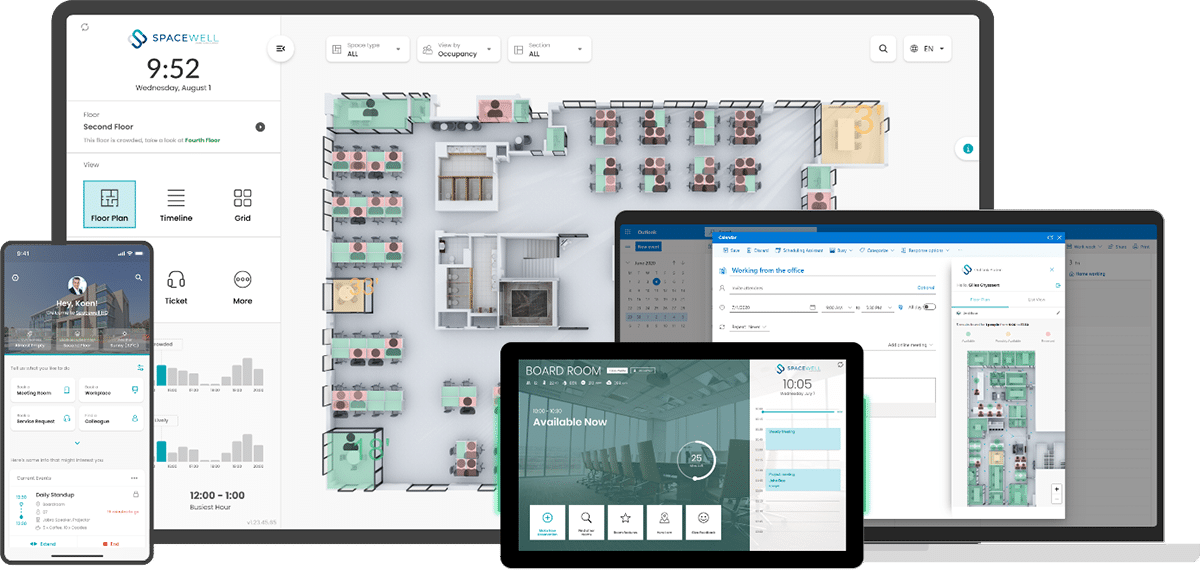In recent years, the way in which companies in the services sector are organized has changed dramatically. They have developed the flex office or flexible office to meet their employees’ new expectations post-pandemic.
If these new ways of working have virtually become indispensable for recruiting and retaining employees, and in particular for offering them fit-for-purpose spaces, you need to have the right flexible office solutions to guarantee optimal organization without operational friction.
Flexible office or flex office: what is it exactly?
Flexible office, flex office, or even dynamic office: all these terms refer to the same concept of flexibly managing the workplace.
What is a flex office?
The concept of the flex office is based on the observation that it is increasingly rare for all employees to be present at the company’s premises at the same time. Evolving teleworking, part-time work, travel, and holidays are all factors that contribute to this situation.
Consequently, it no longer makes sense to continue to maintain offices that can accommodate the entire workforce all at once. Therefore, organizations tend to reduce the size of the workplace so that it remains sufficient for the number of employees likely to be present at the same time. In doing so they avoid unnecessary expenses for rent, heating, and maintenance.
In addition, the flex office incorporates the need to offer different working methods to the occupants of the premises, depending on their current tasks or their wishes: soundproof booths for making phone calls, meeting & huddle rooms, convivial spaces, relaxation areas, etc.
Read also: Embracing Flexibility: Technology to Support Hybrid Workplaces
Why opt for a flex office?
Implementing flexible office principles and practices offers many advantages for companies and their employees.
First of all, a flex office reduces real estate costs through space savings and lower maintenance costs.
Moreover, the flex office encourages employee productivity and creativity; employees can choose the space that best suits their needs and tasks at any given time. They also have access to convivial spaces for their professional meetings, or can work from home if they need peace and quiet. All this flexibility helps prevent the development of a counterproductive routine.
In addition, offering employees working arrangements that are adapted to their wishes and needs improves employee engagement. This flexibility is all the more important as usage has changed considerably: offices are now used much more for collaboration than before, and less for individual work, and as a result, they must provide adapted, pleasant and available collaboration spaces.
Finally, the flex office promotes communication and exchanges within teams. Not only does information circulate more easily and quickly, but teams are more closely knit because everyone has the opportunity to meet one another, unlike a system where everyone always uses the same office and always encounters the same people.
Why adopt a flexible office solution?
A flexible office obviously has many advantages. However, in order for the company and its employees to optimally benefit from this concept and avoid major inconveniences, it is essential to have an IT solution adapted to this type of workspace management.
Read also: What are the advantages of workspace management software for service sector companies?
Possible disadvantages of the flexible office
The introduction of a flexible office entails certain risks if it is not properly managed:
- Conflicts may arise if the implicit rule of ‘first come, first served’ takes hold, causing stress and tension between colleagues, for example, if some always choose what are considered to be the best seats;
- Deterioration in the quality of relationships between colleagues: all too frequent changes of location can hinder the development of quality relationships between employees;
- Depersonalization of workspaces: the absence of a designated desk can, for some people, lead to a feeling of being replaceable, and prevent them from finding their place in the company.
To avoid these issues, one should use a solution specifically designed for the flexible office, offering functionality adapted to this organizational mode.
How can a flexible office solution benefit you?
A dedicated solution provides several features that make flexible office management simpler, smoother, and more efficient.
Obtain information on space usage and ambient conditions
With a solution like Spacewell Workplace, you can use detailed sensor data to build up an accurate picture of how different areas of a building are being used: occupancy levels, air quality, environmental issues, etc. This analysis serves as the basis for any wish to improve the quality of the working environment.
Read also: Optimizing office space configuration – Aligning supply and demand
Reconfigure the space and aid decision making
By monitoring the occupancy and use of workspaces, companies can identify those that are underutilized or, conversely, those that are in high demand. This makes it much easier to reconfigure offices according to the needs and demands of their occupants. Real estate management is also improved, for example by subletting unused space.
Read also: Occupancy monitoring data-driven workplace optimization
Provide a real-time overview of space usage
With an effective flex office solution, the data provided by the sensors is made available to employees in real-time, for example on their smartphones. It allows them to easily find free spaces adapted to their needs at any given time.
Read also: Hoteling, hot-desking, flexible seating, and the hybrid office
Allow services to be adapted to suit the activity
In a flexible office system, services (maintenance, cleaning, etc.) must be adaptable. They should be driven by utilization, which is by nature less predictable than in a traditional set-up. They should no longer be carried out according to fixed schedules but according to the activities going on.
With a flex office solution, the teams responsible for these services receive instructions directly on their smartphones indicating the areas where they can or must intervene. Their tasks are thus dynamically adapted to the actual use of the different spaces, and the working conditions of the office users are improved.
Read also: Creating dynamic services in the workplace with the IoT
Spacewell Workplace, an all-in-one flex office solution
In concrete terms, implementation of the flexible office principles implies a number of preconditions:
- An efficient Wi-Fi network;
- Connections in each workspace;
- A connected file storage system (ideally in the cloud);
- At least one meeting room and at least one phone room dedicated to telephone calls.
A company that meets all these preconditions can then deploy Spacewell’s Workplace solution (Watch an explainer video), which provides all the functionalities needed for smooth and efficient management in flexible mode:
- A space monitoring tool to optimize space use;
- A workplace application to facilitate its use by employees;
- Room reservation software;
- A desk booking application.

Many companies are already applying the principles of the flexible office and the entire services sector is set to adopt them in the short term to meet their employees’ new expectations.
For managers, the issue is no longer whether or not to adopt this method of organizing and managing workspaces, but to equip themselves with the tools that will make it easier and more effective.
By choosing Spacewell Workplace, you give yourself every chance to successfully address this issue and satisfy all your employees’ needs, while simultaneously making substantial savings.






